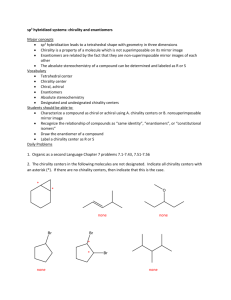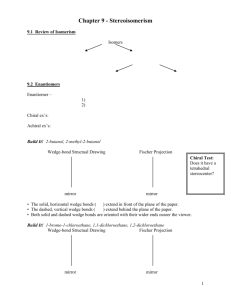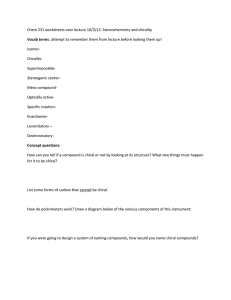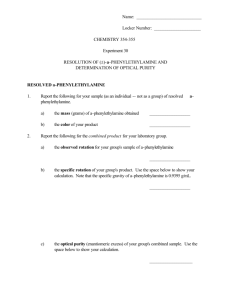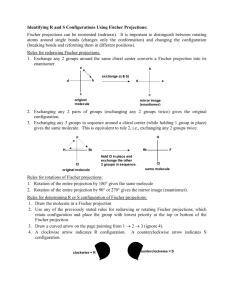5 Lactic acid
advertisement
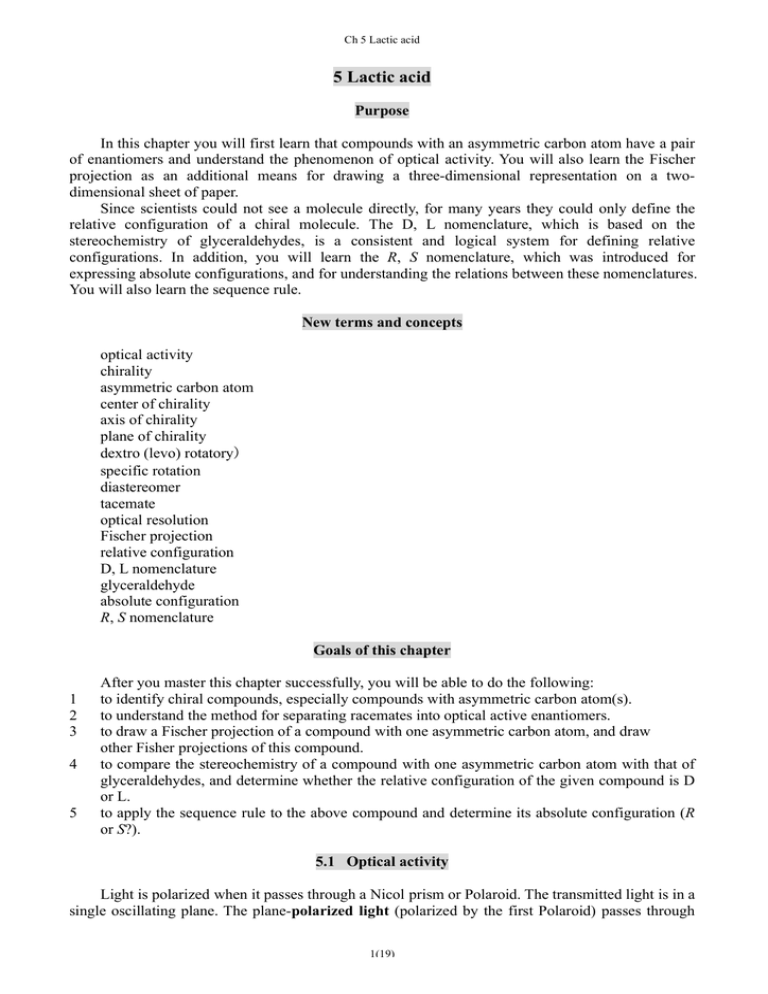
Ch 5 Lactic acid 5 Lactic acid Purpose In this chapter you will first learn that compounds with an asymmetric carbon atom have a pair of enantiomers and understand the phenomenon of optical activity. You will also learn the Fischer projection as an additional means for drawing a three-dimensional representation on a twodimensional sheet of paper. Since scientists could not see a molecule directly, for many years they could only define the relative configuration of a chiral molecule. The D, L nomenclature, which is based on the stereochemistry of glyceraldehydes, is a consistent and logical system for defining relative configurations. In addition, you will learn the R, S nomenclature, which was introduced for expressing absolute configurations, and for understanding the relations between these nomenclatures. You will also learn the sequence rule. New terms and concepts optical activity chirality asymmetric carbon atom center of chirality axis of chirality plane of chirality dextro (levo) rotatory) specific rotation diastereomer tacemate optical resolution Fischer projection relative configuration D, L nomenclature glyceraldehyde absolute configuration R, S nomenclature Goals of this chapter 1 2 3 4 5 After you master this chapter successfully, you will be able to do the following: to identify chiral compounds, especially compounds with asymmetric carbon atom(s). to understand the method for separating racemates into optical active enantiomers. to draw a Fischer projection of a compound with one asymmetric carbon atom, and draw other Fisher projections of this compound. to compare the stereochemistry of a compound with one asymmetric carbon atom with that of glyceraldehydes, and determine whether the relative configuration of the given compound is D or L. to apply the sequence rule to the above compound and determine its absolute configuration (R or S?). 5.1 Optical activity Light is polarized when it passes through a Nicol prism or Polaroid. The transmitted light is in a single oscillating plane. The plane-polarized light (polarized by the first Polaroid) passes through 1(19) Ch 5 Lactic acid the second polaroid when placed so that its lines are those in the first one, but the polarized light is completely blocked when lines of the second polaroid are perpendicular to those in the first one (Fig. 5.1). 2nd polaroid 1st polaroid 2nd polaroid 1st polaroid Figure 5.1 The action of polaroids Compounds that can rotate the plane of plane-polarized light are optical active. Optically active compounds exist as a pair of enantiomers. If one of the enatiomers rotates the polarized light plane clockwise, the other enantiomer rotates it the same amount counterclockwise to an equal degree. Clockwise rotation is “dextrorotatory”, and counterclockwise rotation is “levorotatory”. For dextrorotatory, symbols (+) or d, and for levorotatory, symbols (-) or l are frequently used (Fig. 5.2).a) an optical active substance Figure 5.2 Rotation of the plane of plane-polarized light by an optically active substance The amount of rotation depends not only on the type of the discussed compound, but also on its concentration in the solution, the length of the light path through the solution, the solvent, the wavelength of the light employed, and the temperature. The specific rotation [α] is defined for a given compound as the rotation (°) induced by 1 g/ml solution, 10 cm long, under a specified condition (the temperature, wavelength of the light used, the solvent) as shown below. [α]tλ observed rotation (°) length of the sample(dm) x concentration(g/ml) where λ is the wavelength of the light and t is the temperature. a) Usage of d, l and dl (see later) is strongly discouraged by IUPAC. However, you will often encounter these symbols when you read old literature. 2(19) Ch 5 Lactic acid S5.1 Optical activity an optically active substance: a substance that can rotate the plane of plane-polarized light (as a solid or in a solution) (+), dextrorotatory: the property of rotating the plane of plane-polarized light clockwise (to the right) (-), levorotatory: the property of rotating the plane of plane-polarized light counterclockwise (to the left) S5.2 Specific rotation specific rotation: the amount of rotation (°) under the specific condition; 1 g/ml solution, 10 cm long (+) indicates dextrorotatory, and (-) indicates levorotatory. Q5.1 The rotation due to a 10 % solution of one of the enantiomers of a certain compound was found to be +25°. Predict the rotation of a 20 % solution of the other enantiomer under the same condition. □ 5.2 Chirality Molecules that form a pair of enantiomers are chiral. A chiral molecule is related to its own mirror image in the way that your left hand is related to your right hand. All chiral molecules have at least one of the three kinds of chiral centers, the center of chirality, the axis of chirality or the plane of chirality. Molecules without any chiral center are achiral. There are many chiral substances around you. Hands, gloves, and screws are familiar examples. You will find that chirality quite often plays an important role in relation to the property or function of the substance. A methane derivative, an sp3 hybridized carbon atom with four different ligands, is a good example of compounds with a center of chirality. Such compounds can be represented as CXYZW (X ≠ Y ≠ Z ≠ W). This type of carbon atom is called an asymmetric carbon atom. An asymmetric carbon atom is sometimes indicated by an asterisk (*) in the chemical formula. Q5.2 If you find a center of chirality in the following compounds, mark that carbon atom with an asterisk. (a) CH3CHClCO2H (b) CH2ClCH2CO 2H (c) HO2CCHClCH2CO2H (d) BrCH2CHDCH 2Cl (e) C 2H5CH CHC2H 5 CHCHCH (f) CH3CH 2COCH 3 ( E ) CH3 ( Z ) □ A5.1 -50°.□ Q5.3 Confirm that bromochlorofluoromethane CHBrClF (cf. Ch.1, Q1.7) is a chiral molecule, and that the pair of compounds in Q1.7 is a pair of enantiomers.□ A5.2 (a) CH3C*HClCO2H (e) C 2H5CH CHC*HCH CHC2H5 ( E ) CH3 (c) HO2CC*HClCH2CO2H (d) BrCH2C*HDCH2Cl 3(19) (Z) Ch 5 Lactic acid □ Q5.4 Confirm that the compounds discussed in Q1.6, CH3Cl, CH2Cl2 and CHCl3, are all achiral.□ A5.3 The compound is a typical chiral molecule.□ A5.4 Any carbon atom to which two or more of the same ligand are bonded cannot be chiral.□ S5.3 Chirality chiral molecule: related to its own mirror image in the way that your left hand is related to your right hand. S5.4 Types of chiralitya) center of chirality (asymmetric carbon atom): example; lactic acid, glyceraldehyde axis of chirality: example; allene plane of chirality: example; hexahelicene 5.3 Racemates and optical resolution The two compounds forming a pair of enantiomers have the same physical (e.g., melting point) and chemical (e.g., acidity) properties except for optical rotation and reactivity to chiral reagents. A 50:50 mixture of enantiomers is called the racemate and designated as (±) or dl. Racemates are optically inactive because the effect of one enantiomer is cancelled by the effect of the other enantiomer. The chemical property of the solution of a racemate and that of a single enantiomer are identical, though sometimes they are different in the solid state. Separation of racemates into their component enantiomers is called optical resolution or simply resolution.b) There are three methods of resolution. 1) physical resolution: manual separation when enantiomers crystallize in different crystal forms. 2) chemical resolution: separation by chemical methods, separating the diastereomers obtained by a reaction with chiral reagents. 3) biological resolution: use of a specific enzyme which selectively consumes one of the enantiomers. S5.5 Racemates and resolution racemates: a 50:50 mixture of a pair of enantiomers. resolution: separation of racemates into component enantiomers. Q5.5 Compound A exists as a pair of enantiomers, (+)-A and (-)-A, and its racemate (±)-A. Fill the blanks in the Table below as far as possible. (+)-A specific rotation([α]25D ) melting point (°C) soluility (g / 100g H 2O) 8.54 acidity (pKa) a) b) (-)-A (±)-A 133 119 +155.5° 15.97 3.38 The latter two types of chirality is discussed in 5.7. IUPAC strongly discouraged use of the term; optical reslution.) 4(19) Ch 5 Lactic acid Q5.6 Suggest the difficulties involved in each method of resolution.□ A5.5 specific rotation([α]25D ) melting point (°C) (+)-A (-)-A +155.5° -155.5° 133 133 (±)-A 0 119 soluility (g / 100g H 2O) 8.54 8.54 15.97 acidity (pKa) 3.38 3.38 3.38 Since pKa is a property of a solution, a single enantiomer and its racemate have the same value. Compound A is mandelic acid C6H5CH(OH)COOH.□ A5.6 1) physical resolution: it is rather rare that the two enantiomers crystallize in separate crystals. Often racemates are formed. Thus, an equal number of molecules of each enantimoer associate in the crystal. In such a case, separation is utterly impossible. 2) chemical resolution: It is not easy to find an appropriate chiral reagent. Sometimes the two paired diastereomers have very similar properties that will make chemical separation difficult. 3) biological resolution: it is not easy to find a selective enzyme. Furthermore, the enzyme may consume the one you want. In laboratories, chemical resolution is most popular. Biological resolution is used mostly for industrial processes. Physical resolution can be used when you are extremely fortunate.□ A good example of chemical resolution is that of lactic acid CH3CH(OH)COOH. Since lactic acid is a carboxylic acid, the chiral reagent of choice is a base that may form a crystalline salt with lactic acid. The naturally occurring alkaloid, (-)-brucine, is often employed. The two salts are stereoisomers, or rather, diastereomers. In principle, they are separable by usual chemical methods such as recrystallization from an appropriate solvent. + COO- (-)-brucine H H C OH ( + )-lactic acid diastereomer CH3 + COO- (-)-brucine H HO C H CH3 °° When the racemates belong to different type of compounds, a different chiral reagent should be chosen. In Table 5.1, some resolution reagents are listed. Table 5.1 List of resolution reagents racemate carboxylic acid base (amine) alcohol aldehyde, ketone resolution reagent brucine, strychnine, ephedrine, cinchonine camphor-10-sulfonic acid, tartaric acid, malic acid phthalic acid, succinic acid (via half ester) mentylsemicarbazide, mentylhydrazine 5(19) Ch 5 Lactic acid 5.4 The Fischer Projection Several methods have been introduced to visualize the configuration of the asymmetric carbon atom. You have already learned the flying-wedge drawing. Tetrahedral drawing is another method that was often used in the past. The four corners of a tetrahedron are used to indicate the four ligands. The dashed line represents the hidden edge behind the tetrahedron. Most frequently used is, however, the Fischer projection formula (hereafter simply the Fischer projection). A chiral compound CXYZW is drawn by several methods. According to the rule of the Fischer projection, the asymmetric carbon atom lies in the plane of the paper, the horizontal bonds project above the paper and the vertical bonds beneath. In other words, the Fischer projections 7 and 8 are equivalent to the flying-wedge drawings 3 and 4, respectively. X W Y Z Flying-wedge drawing X Y Z 1 X W 2 X W Z W Z Y Y 3 4 X X Tetrahedral drawing W Z Z Y Y 6 5 X X Fischer projection W W Z Z W Y Y 7 8 Q5.7 Draw the flying-wedge pictures of the enantiomeric pair of compounds CHBrClF using (a) and (b). H Cl (a) (b) □ You will notice that there are several ways of writing the flying-wedge pictures. This point will be discussed in Q5.11. Q5.8 Draw the Fischer projection of the enantiomeric pair of compound CHBrClF with the hydrogen atom located above the asymmetric carbon atom.□ 6(19) Ch 5 Lactic acid A5.7 H H Br Cl Cl Cl F 9 F Br Cl H H F F Br Br 10 11 12 □ You had better use a molecular model to understand that 13 corresponds to 9, and 14 corresponds to 10 and 12. However, the way of drawing is not necessarily unique. If you observe the model from a different angle, 9 and 10 will be seen as 15 and 16. Q5.9 Rewrite the Fischer projections 9 and 10 by (a) exchanging the horizontal ligands and (b) exchanging the vertical ligands. Explain the relation between the original ones and the new ones.□ A5.8 H Br F and F H H H Br or Cl and Cl F F Cl Cl Br Br 13 14 15 16 □ Here lactic acid, the title of this chapter, will be introduced. Lactic acid is one of the most familiar compounds. (+)-Lactic acid occurs in a small quantity in the blood and muscle fluids of men and animals. Its concentration increases in the muscle and blood after vigorous activity. (±)-Lactic acid occurs in sour milk as a result of the activity of lactic acid bacteria. It is also found in molasses due to partial conversion of sugars as in apples, and other fruits, tomato juice, beer, wines, opium, ergot, foxglove, and several higher plants, especially during fermentation. Lactic acid is produced technically by “lactic acid fermentation” of carbohydrates such as glucose, sucrose and fructose. It is interesting that (-)-lactic acid is not found as such in nature. To prepare it, resolution of (±)lactic acid is required. Q5.10 Show the enantiomeric pair of lactic acid by (a) flying-wedge drawing and (b) the Fischer projection.□ A5.9 (a) (b) H H H F Cl ≡ and and Br H Br F Br Cl Br F Cl H F Cl F Cl Br (a) The new one is the enantiomer of the original. (b) the new one is the enantiomer of the original. One exchange always gives the enantiomer of the original.□ Q5.11 Suppose you rotate the Fischer projection clockwise by (a) 90° and clockwise by (b) 180°. Explain the relation between the original and new projections.□ 7(19) Ch 5 Lactic acid A5.10 COOH H COOH OH HO H CH3 CH3 17 18 COOH COOH H OH HO H CH3 CH3 19 20 □ The effect of rotation is the same as that with a combination of exchanges. Thus, a rotation by 90° is equivalent to a three successive exchanges. H F Br H F F Br H Cl Br Cl Cl F Br Cl H Br F Cl H Br F You will obtain the original by two successive exchanges, and the enantiomer by three successive exchanges. You can now generalize that an odd-number exchange will give you the enantiomer. Rotation by 180° is equivalent to two successive exchanges, and you will obtain the original. Rotation by -90° exhibits the same effect as that of +90°. H Br Cl F H Cl Cl Br F Cl Br F F H Br H Q5.12 Draw all possible Fischer projections of each of the enantiomers 9 and 10.□ A5.11 (a) The enantiomer is obtained. H H Br Br rotation by 90° Br F Cl Cl H F (b) The identical species is obtained. 8(19) Cl H F F Br Cl Ch 5 Lactic acid H Cl Cl H rotation by 180° Br F F Br F Br Br H H Cl Cl F □ A5.12 Twelve projections can be written for each enantiomer. For one enantiomer, there are four ways to choose the ligand to be placed top, and three ways to choose the ligand to be placed at the bottom from the remaining three ligands. Thus, 4 x 3 = 12 projections are obtained. If you exchange the right and left ligands, you can obtain the set of Fischer projections for the other enantiomer. H Cl H Br Br H F F F Cl Br Cl F Cl Br H F F Cl Cl H Br Cl H F Br Br H Cl Br H F Cl Br Br Br H F Br Cl F H H Cl F F H Cl □ S5.6 Rules of the Fischer projection exchange: the exchange of even number (2n) gives the original, and the exchange of odd number (2n – 1) gives the enantiomer (n is an integer). rotation: a clockwise rotation by 2n x (π/2) gives the original, and a rotation of (2n – 1) x (π/2) the enantiomer (n is an integer). 5.5 Relative configuration As mentioned before, lactic acid in muscles is dextrorotatory, i.e., it is (+)-lactic acid. This can be determined by experiments. Based on this experimental fact, will it be possible to decide which configuration, 17 or 18, the (+)-lactic acid has? It is impossible unless one can see the molecule! The pioneers of stereochemistry built up a logical system of relative configuration with a few simple hypotheses. The system of relative configuration can be summarized below. 1) 2) 3) Of the pair of enantiomers of glyceraldehydes HOCH2C*H(OH)CHO, the dextrorotatory isomer is assigned to configuration 21, and the levorotatory isomer to configuration 22. (Note that there is no experimental support for this assignment) Compounds that can be derived from either 21 or 22 without changing the configuration of the asymmetric carbon atom are assigned to the D- and L-series, respectively. The stereochemistry of a chiral compound is defined by a combination of two terms, one (D or L) defines the relative configuration, and the other, (+) or (-), indicates the experimentally determined rotation. 9(19) Ch 5 Lactic acid CHO H CHO OH HO CH2OH H CH2OH 22 L(-)-gluceraldehyde 21 D(+)-gluceraldehyde Q5.13 Draw the flying-wedge presentation of 21 and 22.□ There are several ways to draw 24. 24a has a good relation with the Fischer projection 22. 24b is also good because it is clear that 24b is the mirror image of 23. Q5.14 D-lactic acid is dextrorotatory. Can we say all compounds belonging to the D-series are dextrorotatory?□ A5.13 CHO CHO CH2OH H HO CHO CH2OH H OH 23 or CH2OH H OH 24b 24a □ Q5.15 Assign each of the pair of enantiomers 17 and 18 whether it belongs to the D- or L-series.□ A5.14 No. Whether a given compound is (+) or (-) is difficult to predict. The direction of the rotation depends on many factors. For instance, sodium salt of (+)-lactic acid CH3CH(OH)COONa is levorotatory, but the configuration of the symmetric carbon atom is identical with (+)-lactic acid.□ Q5.16 Three Fischer projections of glyceraldehydes are shown below. Identify which series, D- or L-, each Fischer projection belongs to. (a) (c) (b) CHO HOH2C OH CH2OH H OHC OH CH2OH H OH H CHO 25 26 27 □ A5.15 To solve this question, some knowledge of organic chemistry is required. You should know that an aldehyde group –CHO is easily oxidized to a carboxylate group –COOH, and the -CH2OH group can be reduced to a -CH3 group without affecting the stereochemistry of the asymmetric carbon atom. Then, 17 is assigned to D-series and 18 to L-series.□ 10(19) Ch 5 Lactic acid A5.16 (s) D, (b) D, (c) D. CHO ( a ) HOH2C CHO H 1 exchange to change o enantiomer OH HO CH2OH CHO CH2OH (b) 2 exchanges OHC OH H L ( ∴D) H original enantiomer H D OH CH2OH OH OH 1 exchange (c) H CH2OH OHC CHO CH2OH H CHO 90° rotation OH (D) H CH2OH □ It must be pointed out, however, that the assumption, i.e., retention of configuration during the reaction, is not a guaranteed fact. Conventionally the Fischer projection of glyceraldehyde is written as 21 or 22. This comes from the convention for sugars since glyceraldehydes may be regarded as the simplest sugar. In the Fischer projection of sugars, the aldehyde or the most highly oxidized ligand will occupy the top position and the least oxidized ligand the bottom position. Hydroxy group(s) and hydrogen atom(s) are placed right or left depending on the configuration of the carbon atom to which these are bonded. S5.7 Relative configuration (+)-glyceraldehyde 21 is the key compound of the D-series. (-)-glyceraldehyde 22 is the key compound of the L-series. D-series: Any compound derived from 21 without affecting its configuration L-series: Any compound derived from 22 without affecting its configuration. 5.6 Absolute configuration—R, S-convention The system of relative configuration is a self-consistent system except for the initial arbitrary hypothesis. In practice, the system has been effective and is a very important field of organic chemistry, e.g, sugar chemistry and natural product chemistry in general, has been constructed on it. Chemists were, however, anxious to know the truth: what configuration has D(+)-glyceraldehyde? Is it really 21, or is it 22 instead? In 1951, Bijvoet et al. successfully determined the true configuration, i.e., the absolute configuration, of a chiral molecule rubidium sodium salt of tartaric acid by abnormal scattering of X-rays. Quite fortunately, the absolute configuration did coincide with the relative configuration. The hypothesis was correct! Fischer’s gamble was successful! Today the absolute configuration of many compounds has been determined. 11(19) Ch 5 Lactic acid Q5.17 In the history of science, there was one occasion when scientists had to choose one out of two possibilities without sufficient information. Do you know this occasion?□ There were several difficulties in practicing relative configuration when a variety of chiral compounds were treated. Sometimes it was impossible to relate a complex molecule to glyceraldehyde. Fortunately, a new and more versatile stereochemical nomenclature, R, S nomenclature, was proposed. The idea was that the system should be general and be related to the sequence rule that is the basis of systematic nomenclature. The practice of R, S nomenclature is as follows: For each center of symmetry (compounds with many centers should also be considered), 1) 2) 3) 4) 5) The priority of four ligands is decided by the sequence rule. An alphabet is assigned to each ligand according to the decreasing order of priority; L > M > S > s (This is not a part of the rule. It is one step in the procedure.) Suppose you are looking down the bond from the asymmetric carbon atom toward the ligand of lowest priority (s). The other three ligands (L, M and S) will be facing you. Connect these three ligands with an arrow running from highest to lowest priority (L > M > S). If this arrow runs clockwise, the enantiomer is called R (Latin, rectus (meaning right)). If it runs counterclockwise, the enantiomer is called S (Latin, sinister (meaning left)). The label (R ) or (S) is added to the name. S5.8 R, S nomenclature When looking along the bond from the asymmetric carbon atom toward the ligand of lowest priority (s), R-configuration: If an arrow connecting three ligands L-M-S runs clockwise, the enantiomer has R configuration. S-configuration: If an arrow connecting three ligands L-M-S runs counterclockwise, the enantiomer has called S configuration. L L M s S S s M (S)-configuration (R)-configuration Q5.18 Name compounds 9 and 10 by R, S nomenclature.□ A5.17 There might be a few such examples. The most famous one was the decision of the direction of electric current that was a serious problem for scientists at the end of the 18th century. Does it flow from the anode to cathode, or vice versa? Since electrons were not known at that time, the nature of electricity as a flow of electrons was beyond their comprehension. They decided that the electric current flowed from the anode to the cathode. Later it was found that the nature of electric current a flow of electrons which flow from the cathode to the anode. So the hypothesis adopted by 18th scientists was not correct.□ Q5.19 Name glyceraldehydes 21 and 22 by R, S nomenclature.□ 12(19) Ch 5 Lactic acid A5.18 H (s) (S)-configuration H (s) Cl (M) Br (L) (R)-configuration Br (L) Cl (M) F (S) F (S) 9 10 □ If the absolute configuration and rotation are simultaneously indicated, two labels are used; e.g., (R)-(+)-glyceraldehyde. Q5.20 Draw the flying-wedge diagram of the following compounds. (a) (S)-2-butanol CH3CH2CH(OH)CH3 , (b) (R)-lactic acid□ A5.19 First of all, one must decide the priority of the ligands. 1st atom OH CHO CH2OH H O1(L) C2 C3 H4 (s) O21O22H23 (M) O31H32H33 (S) 2nd atom CHO (M) H (s) (L) HO CHO (M) CH2OH (S) (S) HOH2C H (s) OH (L) (R)-configuration (S)-configuration Q5.21 Devise a convenient procedure to decide (R) or (S) from the Fischer projection. Use the three compounds below as examples. CH2OCH3 H Br CH2NH 2 CO2CH3 HO H Cl Br CH3 CH2Br CH2NHCH3 30 31 32 □ □A5.20 The priority of the ligands is as follows. (a) OH > C2H5 > CH3 > H, (b) OH > COOH > CH3 > H. Note OH > COOH.□ 13(19) Ch 5 Lactic acid OH (L) OH (L) (s) H CH3 (S) C 2H5 (M) COOH (M) (s) H CH3 (S) 29 28 Q5.22 In textbooks of stereochemistry, an automobile steering wheel is often used as a very good analogy in explaining how to use R, S nomenclature. Explain why with the help of the figures for A5.21 □ A5.21 30 Br > CH2OCH3 > CH3 > H, 31 OH > CH2Br > COOCH3 > H, 31 Br > Cl > CH2NHCH3 . > CH2NH2. The point is to convert a Fischer projection into the one where the ligand of lowest priority occupies the bottom. Then you have a Fischer projection that will give you much the same information as 28 and 29 do. CH2OCH3 H Br M CH2OCH3 Br CH3 CH3 L S R-configuraion L R-configuraion M S-configuraion s H 30 CO2CH3 HO H S CO2CH3 BrH2C CH2Br M OH H s CH2NHCH3 S 31 CH2NH 2 Cl Br Br CH2NHCH3 Cl L CH2NH 2 s 32 □ Q5.23 Suppose your elbow represents s, and your middle finger, index finger and thumb stand for L, M and S, respectively. How you can decide R or S for a given chiral compound?□ A5.22 It is clear that there is a good resemblance between a steering wheel and the rightmost figures in A5.21. The analogy is clear (see below). s 14(19) Ch 5 Lactic acid L L M S M S S-configuraion R-configuraion □ A5.23 With this assumption, a (R)-enantiomer will have the same arrangement of ligands as your right hand.□ S5.9 How to decide the configuration by R, S nomenclature. from the Fischer projection: Convert the Fischer projection so that the ligand of the lowest priority comes to the bottom. Follow the direction L > M > S. If it is clockwise, the configuration is R; if counterclockwise, it is S. from the flying-wedge drawings or molecular model: the procedure is the same. Allene and helicenea) 5.7 (a) Allene Allene (33) is a very characteristic compound consisting of three carbon atoms. The central carbon atom is sp hybridized and the two terminal carbon atoms are sp2 hybridized. H Y H C1 C2 W C3 C1 H H C2 C3 Z X 33 34 Consequently, in 34, the plane containing C1, C2 and ligands X and Y, and the plane containing C2,C3 and ligands Z and W are orthogonal. Q5.24 A compound 35 is obtained by replacing X, Y, Z and W of 34 with F, Cl, Br and H, respectively. A compound 36 is obtained by replacing X, Y, Z and W of 34 with F, Cl, H and Br, respectively. Are 35 and 36 identical or isomeric? F F Br H C1 C2 Cl C1 C3 C2 Cl Br C3 H 36 35 □ It is interesting to notice that there is no asymmetric carbon atom in 35 and 36 and yet these are optically active. The characteristic feature of 35 and 36 is that they have orthogonal planes (see 34’) and is that they are not bisected by a plane of symmetry. If two such orthogonal planes are for some reason fixed, the molecule will become chiral. In the case of allene, the overlap of p orbitals (gray one and white one in 33 and 34) fasten the two planes. a) This section treats a slightly advanced topic. You should, however, be able to understand the essence of this topic easily if you study with the aid of molecular model. 15(19) Ch 5 Lactic acid 90° Y W C C C X Z 34' Since the origin of chirality in these compounds is the axis (C1-C2-C3 in the case of 34), this type of chirality is called the axis of chirality. Q5.25 Find the condition that 34 is chiral. Should all ligands X, Y, Z and W be different?□ A5.24 35 and 36 are stereoisomers. In fact these form a pair of enantiomers. This can better be visualized if you rotate 35 by 180° to 35’(=36). You are advised to use a molecular model. F F Br H C1 C2 C3 C3 Cl C2 C1 Cl H Br 35 35'(=36) □ Q5.26 Determine whether allenes 37~39 are chiral or not. Me Ph C C C C Me H H H C C Me H H C Me C Me Ph 38 37 C 39 □ A5.25 Compound 34 will be chiral if X ≠Y or Z ≠W. Hence the requirement for an axis of chirality is loose as compared with that for a center of chirality. Confirm that 40 and 41 is a pair of enantiomers. H H H Me C C Me C C C Me H C Me 41 40 □ A5.26 37: achiral, 38: chiral, 39: chiral.□ (b) Benzene Benzene (42), C6H6, is one of the most important compounds and the key compound of a large family of aromatic compounds. The German chemist Kekulé proposed a cyclic structure for benzene 16(19) Ch 5 Lactic acid in 1864, and that cyclic structure is now called the Kekulé structure (a). (a) Kekulé structure (b) resonance (c) delocalization 42 The Kekulé structure as originally proposed conveniently coincided with its molecular formula, but its chemical stability was not consistent with its having three double bonds which should be highly reactive. In the 20th century when the theory of chemical bonds have made great progress, several proposals were made concerning the structure of benzene. Resonance theory was introduced to explain the stability of benzene. Resonance theory assumed a rapid exchange between the two Kekulé structures (b) as explaining its the stability. In quantum chemical theory, the six p orbitals of the six carbon atoms of benzene overlap each other to allow six π electrons to delocalize throughout the ring (c). Because of this delozalization, all C-C bonds have the same length. The delocalization model is given in Fig. 5.3. X-ray crystallographic analysis has confirmed that all six carbon and six hydrogen atoms of benzene lie in a plane; i.e., benzene is a planar molecule. π bond H H H H H H σ bond 2p orbital of carbon Figure 5.3 Delocalized structure of benzene (42) Biphenyl (43), C12H10, is a compound in which two benzene rings are connected by a single bond. By analogy with benzene, it is expected that all twelve carbon and ten hydrogen atoms of 43 lie in one plane (a). In fact the two benzene rings are not coplanar. There is some steric repulsion between the two ortho protons as shown in 43(b). Because of this repulsion, the two rings is tilted to some extent (c). H H H H (a) (b) (c) 43 It can be expected that the bulky substituents at the ortho positions of 43 will inhibit rotation about the C6H5-C6H5 bond. In other words, the C6H5-C6H5 bond connecting the two benzene rings will fix two planes. Then the C6H5-C6H5 bond will be an axis of chirality as is the case with allenes. 17(19) Ch 5 Lactic acid Q5.27 Confirm, preferably with the aid of a molecular model, that compound 44 is chiral. NO2 COOH HOOC NO2 44 □ A5.27 44 satisfies the condition X ≠Y or Z ≠W. You had better make a molecular model of 44. □ If two benzene rings share an edge, naphthalene 45 is formed. When a third benzene ring fuses wirth 45 by sharing one edge, there are two ways of fusing: one will give anthracene 46 and the other phenanthrene 47. 3 1 1 2 2 45 3 1 2 47 46 If additional fusion of benzene rings proceeds in the manner 42→45→47, a series of helicenes are formed. There is no problem with tetrahelicene 48 but with pentahelicene 49 the possibility of steric repulsion between the protons of benzene 1 and benzene 5 is expected. In hexahelicene 50, the molecule cannot be coplanar because of collision of benzene 1 and benzene 6. There are two ways to avoid this collision: in one way, benzene 6 will ride on benzene 1 (50) and in the other way benzene 6 will creep below benzene 1 (51). 5 4 2 48 1 3 1 2 49 5 4 6 3 3 1 5 4 2 50 Q5.28 Discuss the stereochemical relation between 50 and 51. 4 6 3 1 2 51 □ It may be a little difficult to obtain the answer from the drawings in this textbook. You can cut a postcard or any kind of cardboard into the cornered circle 52. Then cut the junction of 1 and 6, and make benzene 6 ride on benzene 1 and in some way fix it to obtain 51. Then make benzene 6 creep below benzene 1 and fix it by some means to obtain 52. Careful comparison of 51 and 52 will give you the right answer. Perhaps you may find a good analogy in right-handed and left-handed screws. 18(19) Ch 5 Lactic acid 1 6 1 6 53 52 1 6 54 A5.28 50 and 51 (hence 53 and 54) are a pair of enantiomers. Rotation of 50 and 51 by 60° counterclockwise will give you 50’ and 51’. The new pair will show you their chirality more clearly. 4 3 5 4 5 2 6 3 2 1 6 1 50' 51' □ Compounds 50 and 51 do not have any center of chirality or axis of chirality, yet these are optically active. The origin of the chirality of hexahelicene is the presence of a plane of chirality in the molecule. This plane contains benzenes 2,3,4 and 5 but benzenes 1 and 6 are above or below the plane. 19(19)

